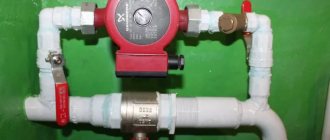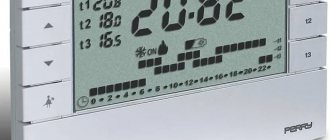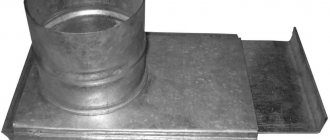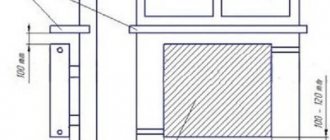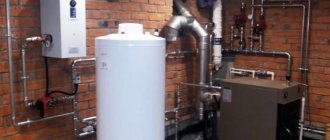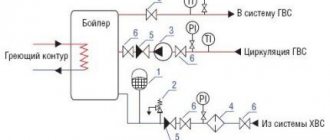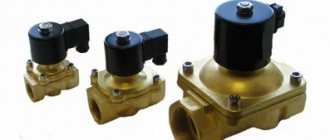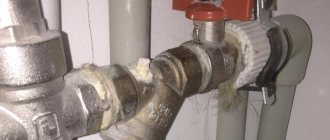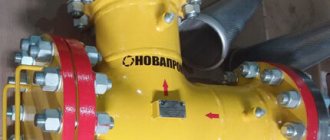High performance and equipment with modern technologies cannot provide a 100% guarantee against failure of the water supply system of a private home. The only thing that can protect you in such a situation is a special spare container. Let's consider what a storage tank for water supply is, what it is intended for and how it is used, what types there are and how to choose the right one based on volume and material, what are the main connection options, as well as how to properly combine it with a centralized and autonomous water supply system.
Storage tank with pump in the house Source stroy-podskazka.ru
Storage tank - what is it, purpose, application
Water, along with light and heat, is the primary factor in the life support of a home. Therefore, the slightest violation in her usual method of delivery leads to extreme discomfort. Until recently, the only way to solve this problem was to reserve a certain amount of water in bottles, canisters, and barrels. However, if not used for everyday needs, it quickly deteriorates and becomes unsuitable for drinking and cooking.
A modern way to solve this problem is a special water storage tank for the home, combined with both a centralized water supply and water intake from a well, well or natural reservoir. Such a reserve tank is used in the following series of cases:
- Periodic or emergency shutdown of centralized water supply, as well as when water is supplied not constantly, but according to a schedule.
- Low performance of an autonomous source.
- Frequent shutdowns of pumping stations due to power failures.
Drives can be very different in capacity, depending on the needs of the consumer Source ireland.apollo.com
- Clogging, silting and other technical malfunctions of a well or well.
- The supply system is completely autonomous - it functions only using imported water.
The peculiarity of a private water supply is such that these and many other small reasons can arise one after another, and sometimes simultaneously. At the same time, troubleshooting always requires a certain period of time, sometimes reaching several days or weeks.
In addition to ensuring stability in the water supply, the storage tank performs a number of other technical functions that are essential for equipment, fittings and pipelines:
- Equalizing pressure in the system.
- Prevention of water hammer.
- Reducing the load on pumps and their operating time.
- Increased equipment service life.
Advice! To conveniently and quickly activate the reserve water supply, the reserve tank must be connected to the water supply so that if the main supply is interrupted, the additional one is turned on automatically or by turning the valve.
The storage tank can be easily integrated into the home water supply scheme Source oboiman.ru
Installation of water supply
The installation of the water supply network is carried out in stages.
If water is extracted from a well, a pump is installed on it.
Its type depends on the depth of the source:
- up to 8 m – surface pump;
- from 8 to 20 m – surface pump with a remote ejector;
- over 20 m – submersible pump.
The suction line of the surface pump must be equipped with a check valve. If a submersible pump is used, a check valve is installed on the pipeline leading to the house.
Storage circuit with pumping station and hydraulic accumulators
In automatic mode, the pump is turned on and off by coordinated signals of three elements:
- level sensor installed in the well;
- dry running protection relay;
- float switch installed in the storage tank.
Using a flexible reinforced hose with a diameter of 1" the pump is connected to a polyethylene pipeline (outer diameter - 32 mm) laid to the storage tank.
If the tank has a large volume and is installed on an interfloor ceiling, a flooring of thick boards should be laid under it, which will distribute the weight load over a large surface.
Water supply to the house from a well with a storage tank
Installation of the float valve is carried out in the following order:
- A washer is put on the valve shank, after which it is inserted into the inlet hole.
- Then, from the inside, they put on the shank: a stiffening plate, a second washer and a fixing nut.
- Now, from the outside, you need to screw the adapter to the shank, to which the supply pipeline will be connected.
- The float switch for the pump is installed in the same way.
When installed at the top, the tank remains connected to the sewerage system and water supply network. If the tank is located underground, it is necessary to install and connect a pumping station with a membrane accumulator. Like a well pump, the station must have dry-running protection, which will turn it off as soon as the tank is empty.
Design and principle of operation
A storage tank for water is a reservoir of a certain volume, equipped with the following devices:
- Inlet tube. Through it, the reservoir is filled from the main source - a well or a central pipeline.
- Float mechanism. This can be a regular float, similar to the device of a toilet flush cistern, or a special valve that, when the tank is full, turns off the supply pump or closes the tap.
- Drain pipe. To prevent the container from overfilling and causing flooding of the room, in case the float mechanism does not work, a drain tube is installed in the upper part, through which excess water is removed.
- Filter. There are several types of filter devices installed on the inlet artery - mesh, cyclonic and centrifugal type. The first is used when there is slight contamination, the last two are used when there are impurities visible to the naked eye. The filter mesh can also be mounted on the outlet pipe from the tank.
Modern filtration system for a storage tank Source terman-s.ru
- Drainage and cleaning tube. When using a container for a long time, even with a good filter, a layer of contaminating deposits inevitably accumulates at the bottom. A drainage pipe is used to periodically remove them.
- Luke. If a private house has a basement or basement, then a water storage tank is often installed there. However, with such a low location of the tank, it is almost impossible to install a drainage system. Therefore, for periodic cleaning, a hatch is required in the upper part, through which you can penetrate inside and clean the bottom of dirt.
- Diffuser. A device that disperses water flow similar to a watering can. Installed on the supply tube. Prevents active mixing of the upper layers with bottom sediments.
- Level. As a rule, the walls of the tank are opaque. Therefore, to accurately determine its fullness, a level is mounted.
Design of a membrane storage tank Source montagtrub.ru
See also: Catalog of companies that specialize in garden furniture and storage systems
- Ventilation pipe. Regardless of whether the container is equipped with a hatch or not, when closed it is a hermetically sealed capsule. Therefore, so that when opening the tap, an internal vacuum of air does not form, and this results in water retention, a ventilation valve or tube is installed in the very top part.
The mechanism of action of the reserve tank is largely determined by its location - if it is located at a sufficiently high level in relation to the receiver (faucet, shower, etc.), water can flow out of it by gravity, if lower or at the level, then under the pressure generated a pump specially installed for this purpose.
Tank monitoring and maintenance.
If the pump starts and stops noticeably more often, it means that air has leaked from the tank, or the membrane has leaked. Unscrew the cap of the tank nipple and press on the stem. If water comes out, then the membrane is torn and the tank needs to be replaced. If nothing works, or air hisses, then you need to pump it up: • disconnect the pump from the power supply. • open any cold water tap and wait until the flow dries up. It's a shame to waste hot water. • pump up the pressure, for example with a car pump, • close the clan. • turn on the pump power.
Varieties
Reserve tanks to ensure uninterrupted water supply are classified according to the following number of parameters:
- Shape - can be cylindrical, rectangular, square, etc.
- Type of construction - open and closed type, that is, with and without a hatch - completely sealed membrane.
- There are various types of housing material used – from stainless steel to food-grade plastic. At the same time, its composition must exclude harmful substances that can pass into water.
Storage containers most often have a plastic body Source septik.guru
- Capacities - depending on the conditions of use, the useful volume can be very different - from 10 liters to 1 m³, etc. It is also possible to combine several containers into one system.
- Purpose - for drinking and cooking, for watering the garden, for the heating system, for cold or hot water supply, for other technical needs.
- Installation features - vertical or horizontal placement, indoors or outdoors, on the surface, at height or underground.
Note! To ensure uninterrupted water supply to a private home, it is not necessary to purchase and install an additional pump for a storage tank. Special membrane hydraulic accumulators create a certain pressure - sufficient for convenient use of a tap, shower and other household needs.
Heat accumulator calculation
The calculation formula is very simple:
Q = mc(T2-T1), where:
Q—accumulated heat;
m is the mass of water in the tank;
c is the specific heat capacity of the coolant in J/(kg*K), for water equal to 4200;
T2 and T1 are the initial and final temperatures of the coolant.
Let's say we have a radiator heating system. The radiators are selected for the temperature range of 70/50/20. Those. When the temperature in the battery tank drops below 70C, we will begin to experience a lack of heat, that is, simply freeze. Let's calculate when this will happen.
90 is our T1
70 is T2
20 – room temperature. We won't need it in our calculations.
Let's say we have a heat accumulator with a capacity of 1000 liters (1m3)
We calculate the heat reserve.
Q=1000*4200*(90-70)=84,000,000 J or 84,000 kJ
1 kWh = 3600 kJ
84000/3600=23.3 kW heat
If the heat loss at home is 5 kW on a cold five-day period, then the stored heat will be enough for us for almost 5 hours. Accordingly, if the temperature is higher than the calculated one for a cold five-day period, then the heat accumulator will be sufficient for a longer time.
Selecting the volume of a heat accumulator depends on your tasks. If you need to smooth out the temperature, set a small volume. If you need to accumulate heat in the evening in order to wake up in a warm house in the morning, you need a large unit. Let there be a second task. From 2300 to 0700 – there should be a supply of heat.
Let's assume that heat loss is 6 kW, and the temperature regime of the heating system is 40/30/20. The coolant in the heat accumulator can heat up to 90C
Reserve time 8 hours. 6*8=48 kW
M=Q/4200*(T2-T1)
48*3600=172800 kJ
V=172800/4200*50=0.822 m3
A heat accumulator from 800 to 1000 liters will satisfy our requirements.
Capacity volume and material
When choosing a drive, in addition to other technical nuances, you first need to determine what material its body should be made of and what its usable volume should be for everyday needs.
A plastic container can be installed outdoors without additional protection Source sovet-ingenera.com
Material
Most often, the materials used in the manufacture of the tank body are:
- Polyvinyl chloride.
- Polypropylene.
- Cross-linked polyethylene.
- Stainless steel.
- Steel coated with a layer of waterproof coating - varnish, ceramics.
- Galvanization.
To equip drinking water supply and related household needs (washing dishes, showering, etc.) for a private home, food-grade plastic containers are most often chosen. Its main advantages over metal analogues are inertness, safety (does not emit harmful components), corrosion resistance, durability, light weight - which is convenient for transportation, installation and maintenance.
Types
The storage tank can be a container with sufficient internal volume, made of a material that is resistant to corrosion and safe for storing drinking water. The following materials are used:
- polyvinyl chloride;
- cross-linked high or low pressure polyethylene;
- polypropylene;
- stainless steel;
- steel coated with waterproof varnishes and ceramic coatings.
Plastic Tanks
Although galvanized steel is corrosion-resistant and waterproof, over time the protective layer of zinc can wear thin, especially at joints and welds.
By design there are:
- open containers that have a neck with or without a lid, but with sealed walls and bottom;
- closed, completely sealed membrane-type containers.
In the first case, everything is simple: the entire internal volume is filled with water and, if necessary, drained through a pipe fixed at the lowest point.
In the case of membrane storage tanks, the useful volume is at least a third less than the volume of the entire structure. Part of the volume is allocated under the air chamber, separated from the water using a durable elastic membrane. As the container fills with water, the membrane presses on the air chamber, creating excess pressure. When it is necessary to get water back, the valve opens and it enters the water supply system under the influence of accumulated pressure.
Connection options
There are two main options for connecting a water storage tank in your home:
- Together with the central water supply.
- As part of an autonomous water supply system.
Moreover, in each of the schemes there are several options for installing the tank. Let's look at them in more detail.
Scheme of autonomous water supply with a membrane tank Source moikolodets.ru
Combination with centralized water supply
When the source of water supply is the central water supply, the reserve tank ensures an uninterrupted supply of water in the event of a power outage or reduction in pressure. In this case, there are 3 main ways to connect the tank:
- Upper.
The container can be installed either under the ceiling on the 1st floor or on the floor of the 2nd, in the attic or in the attic. In any case, the outlet pipe must be higher than the level of the water intake source - tap, toilet, etc. The tank must be equipped with 3 fittings:
- The top one is for filling.
- Extremely upper - to drain water in case of overflow.
- Bottom - for supply to the house water supply.
Water is supplied to the container through a tee installed immediately after the filter, meter and check valve. Next, the pipe from it is connected to the upper fitting through a valve and a float mechanism. The lower fitting is connected to the house water supply through a shut-off valve and a tee via a pipe.
Volume of the tank
In the event of problems with the city water line and a water outage, repair work is usually completed within a day or two. However, accidents also happen on holidays, and in places where quick repairs are simply impossible, then you will have to wait much longer. The optimal supply of water for 2-3 days will be for using the toilet, maintaining personal hygiene and cooking.
For a family of three people, 100 liters per day is enough when using water in economy mode. One wash requires approximately 80 liters of water, more precisely you can find out in the passport for the washing machine. Same for the dishwasher.
It turns out that for 2-3 days when using household appliances, you need to look for a storage container with a volume of at least 500 liters, half a cubic meter.
However, there are a number of restrictions:
- The larger the volume of water and an open storage tank, the faster it will begin to become overgrown with sediment. It is not recommended to use containers larger than 200-250 liters in everyday life for long-term storage of water.
- The safety margin of the floor and load-bearing walls should be taken into account. The installation of the tank must be planned at the design stage of the house.
- When using an autonomous water supply, the volume of the storage tank, especially the membrane type, should not exceed the flow rate of the well. If this rule cannot be observed, then the pump must be protected from idle running.
Membrane-type storage tanks are limited in volume and are not able to release the entire supply of stored liquid. To form a reserve of over 300 liters, you will have to connect several tanks of smaller capacity in parallel to each other.
Video description
Video example of arranging a home water supply system using a storage tank:
Only one pipe is used for connection. Its installation location is the same as in previous cases - after the filter, meter and valve. In this case, for correct installation it is necessary to first adjust the pressure of the internal chamber. It must correspond to the operating pressure of the water supply.
Arrangement of autonomous water supply
There are several options for connection:
- Like a water tower.
The storage tank is installed in the attic, the top floor of a private house or a tower specially built for this purpose, and water is supplied to it by means of a pump. In this case, to achieve normal pressure, the lower outlet pipe must be located above the ground at least 10-15 meters. The pressure in the system is determined by the difference in height between the container and the receiver.
The main advantage of this water supply option is the minimum cost. The disadvantage is the need to regularly clean the tank from accumulated sediment, as well as mandatory insulation if it is located outside a heated room.
Initial pressure in the tank.
Рb
– initial pressure of the gas cushion in the tank, bar. Tank manufacturers recommend setting it 0.5 bar below the pump start pressure (Pmin). This is correspondingly 0.5 bar less than the relay response pressure. We need 1.5 bar. Typically the factory pressure is 1.5 bar, so check the actual value before installing into the system. For example, a car pump. Fig.4. Nipple on expansion tank.
q
— design flow rate, l/sec.
Use this table to calculate q. Insert the l/min values into the Excel file, and it will calculate the required tank volume. It is also available in the Excel file. Fig.5. Water consumption table. Table source: https://ibuildrussia.ru/kak-vybrat-elektricheskij-protochnyj-vodonagrevatel
Video description
Video instructions on how to make pressurized water supply to your home and property through a membrane storage tank:
- Lower.
The container is installed on the floor or on the ground. Filled under pump pressure. Operation of the system also requires constant operation of the equipment. Which makes the water supply completely energy dependent.
This option is ideal for low well productivity. First, the tank is pumped at a speed limited by the parameters of the source, and then it is consumed according to consumer needs.
- Membrane accumulator.
This is another way to supply water from the lower location of the storage tank when the system is not equipped with a pump. Initially, water is drawn into the container from the well, and then enters and is distributed through the internal water supply under the influence of pressure generated by the membrane accumulator.
On a note! When placing a tank in an attic, tower, basement or any other unheated place, insulation and a suitable heating system are required - both inlet and outlet pipes and the body.
Popular Russian-made models
Reliable and inexpensive equipment in demand includes domestic brands that have proven themselves to be worthy representatives of the budget segment. Vivid examples of such brands:
- BTS,
- "Teplodar"
- Biysk boiler house,
- "Prometheus",
- "Gorynya"
- "Water scheme".
The products were highly appreciated by consumers, especially models 500 and 750 (the marking corresponds to the useful volume). Products of modern design made of enameled steel have an acceptable weight for this niche - 165 and 195 kg, respectively, they are aimed at solid fuel boilers.
offers a popular budget solution - the U200 thermal accumulator with a capacity of 200 liters. It is a safe and effective solution designed to serve small systems.
Along with heat accumulators for heating boilers made in Russia, products from Sweden, Hungary, and the Netherlands are in demand. It is noteworthy that domestic models are not inferior to foreign ones in service life and build quality, but the price is significantly lower.
Briefly about the main thing
The storage tank ensures constant water supply in a private home in the event of a planned or sudden shutdown of the central water supply or breakdown of the autonomous system. It eliminates the problems of water supply failure associated with a number of the following reasons - low well productivity, equipment breakdown, siltation of the source, power outage, etc. In addition, it reduces the load on equipment and pipes and extends their service life.
A standard water tank consists of the following elements:
- Cases.
- Inlet, outlet and drain tubes.
- Float mechanism.
- Filter.
- Luke.
- Drainage pipe.
- Diffuser.
- Ventilation.
The tank is classified according to several criteria - shape, design, material, volume, purpose, installation method. When choosing it, volume and material are first taken into account. Installation is possible both in an autonomous system and in conjunction with a centralized water supply. In each case there are several installation methods.
Buy or make it yourself?
This question concerns, first of all, risks, not costs. Heating equipment is a balanced system, and the introduction of a component that has not passed factory tests, the performance parameters of which are only indicative, can cause a breakdown of the entire circuit. The savings resulting from self-assembly are offset by the potential costs of debugging and repairing expensive units.
Thermal accumulator U200 Prometheus - a budget solution for small systems
A professional calculation of a heat accumulator will allow you to purchase a model that optimally meets the operating conditions and the needs of residents. In this case, one should expect a reduction in energy costs, which is more significant compared to the cost of the device.
